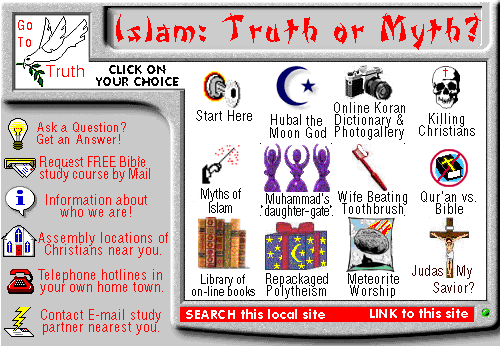The Hadith of Islam
The Muslim Hadith is to the Koran, what an engine is to a body of a car. Without the Hadith, the Koran simply won't drive by itself!
- Muhammad claimed to be restoring the religion of Abraham (VI, 161/162; III, 65/58 ff.; II, 124/118 ff.), yet his religion was clearly not that of the Jews or the Christians, who also claimed to be the spiritual children of Abraham. In the Qur'an we find certain [vague] directions about prayers, alms, fasting, and pilgrimage, and it seems highly probable that Muhammad during the years in Madina gave his followers some definite formulation of the things they were to believe and the religious rites they were to practice. No such [definite] formulation appears, however, either in the Qur'an or in the earliest strata of Tradition. (Islam: Muhammad and His Religion, Arthur Jeffery, 1958, p 71)
- After the Prophet's death, however, the growing community of his followers found that a great many problems of religion and even more of community life were arising for which there was no specific guidance in the Qur'an. Guidance was therefore sought in the Traditions, Hadith as to what the Prophet had said and done, or was reported to have said and done. This vast accumulation of genuine, partly genuine, and quite spurious traditions was presently digested into the collections of Hadith, six of which are considered to be the canonical collections. [These six canonical collections of Hadith are: the Sahih of al-Bukhari (d. 256 A.H., 870 A.D.), the Sahih of Muslim (d. 261 A.H., 875 A.D.), the Jami' of at-Tirmidhi (d. 279 A.H., 892 A.D.), the Sunan of Abu Dawud (d. 275 A.H., 888 A.D.), the Sunan of Ibn Maja (d. 273 A.H., 886 A.D.), and the Sunan of an-Nasa'i (d. 303 A.H., 915 A.D.).] But as these canonical collections were primarily concerned with material of a juristic nature, it follows that much material of importance for the religion of Islam had to be drawn from the other, uncanonical collections. It was well known to Muslims that much of the Hadith material was spurious, but for the study of Islam even those traditions which the community invented and attributed to Muhammad have their value, often as much value as those which may actually have come from him. (Islam: Muhammad and His Religion, Arthur Jeffery, 1958, p xi-xiv)
- The earliest Muslim Life of the Prophet that has come down to us is one by Ibn Hisham (d. 219 A.H. = 834 A.D.). (Islam: Muhammad and His Religion, Arthur Jeffery, 1958, p 3-4)
- Of the first type of collection the most important example was doubtless the Musnad of Ahmed ibn-Hanbal who lived in Baghdad in the second century of the Muslim era (A.D. 780-855). As edited by his son `Abd Allah, this voluminous work contained nearly thirty thousand traditions grouped under the names of seven hundred companions of the prophet. (The Archeology Of World Religions, Jack Finegan, 1952, p 492)
- Of the second type, some six collections, all of which arose during the third Muslim century, attained the highest recognition. These were made by the following authorities: (1) al-Bukhari (d. A.D. 870) ; (2) Muslim (d. A.D. 875) ; (3) Abu Dawud (d. A.D. 888) ; (4) al-Tirmidhi (d. A.D. 892) ; (5) al-Nasa'i (d. A.D. 915) ; (6) ibn-Madja (d. A.D. 886). Together these works are known as "the six books" (al-Kutub al-Sitta ), while the first two are singled out for designation as sahih or "sound," meaning that their tradition is utterly faultless. (The Archeology Of World Religions, Jack Finegan, 1952, p 492)
- The oldest collections of historical traditions available to us date from about 125 years after the Prophet's lifetime. Much imagination may have gone to work in the meantime. And yet many facts can be established, as the parties who differ most widely are agreed on the main events of the Prophet's life, the names of his Companions and his wives, their kinship and genealogy, as well as on a great many other things, even down to details which are far from remarkable which nobody would have deemed worth inventing. But there are many points on which we are very far from certain; in particular, it is clear that little was known about the early years of Muhammad's life, and that much has been made up about it. I shall occasionally quote some of these tales, whose only virtue from an historical point of view is that they create a picture of a world not unlike that in which the young Muhammad must have grown up, besides giving us some idea of the way in which later Muslims pictured the life of their prophet. (Mohammed, Maxime Rodinson, 1961, translated by Anne Carter, 1971, p 38-49)
Written by Brother Andrew

Go To Start: WWW.BIBLE.CA
